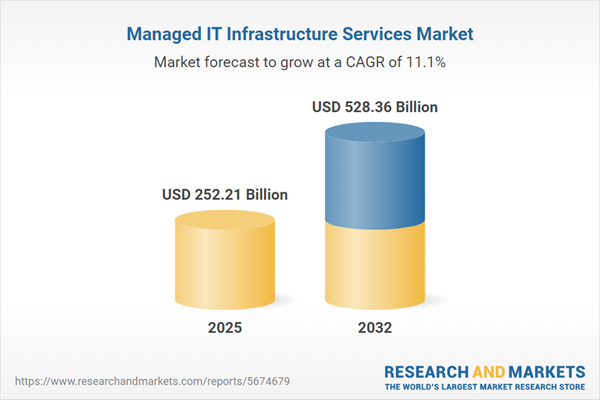Speak directly to the analyst to clarify any post sales queries you may have.
Managed IT infrastructure services have become pivotal for enterprises seeking streamlined technology environments, increased business resilience, and responsive adaptation to changing compliance and operational demands. Senior decision-makers rely on these solutions to achieve greater efficiency, risk management, and strategic technology alignment within an evolving enterprise landscape.
Market Snapshot: Managed IT Infrastructure Services Market Growth
The managed IT infrastructure services market is expanding, with forecasts indicating growth from USD 227.36 billion in 2024 to USD 252.21 billion in 2025, ultimately reaching USD 528.36 billion by 2032. This growth is being driven by increasing demand for outsourced IT operations, expert consulting services, and end-to-end support for enterprise digital transformation. Organizations are adjusting deployment strategies in light of regional regulations and diverse digital maturity, which influences the evolving landscape of managed infrastructure services worldwide.
Scope & Segmentation: Executive-Level Market Overview
This report offers leaders a comprehensive view across core segments essential for aligning technology investments with business goals and operational needs:
- Service Types: Includes Voice-over-IP (VoIP), collaboration suites, managed compute and storage, specialized security services such as firewall management, and ongoing vulnerability assessment.
- Deployment Modes: Features cloud, hybrid, and on-premises models, each catering to compliance, data retention, and standardization policies.
- Organization Sizes: Solutions specifically designed for large enterprises, midsize organizations, small businesses, and micro firms, supporting scalable technology adoption.
- Components: Encompasses IT hardware, strategic industry consulting, process automation tools, and governance platforms that enhance infrastructure observability and efficiency.
- Industry Verticals: Spans banking, financial services, healthcare, manufacturing, energy, utilities, public sector, retail, e-commerce, telecommunications, and IT service providers, with each sector facing distinct compliance and operational challenges.
- Geographies: Covers the Americas, Europe, Middle East and Africa, and Asia-Pacific, recognizing the impact of regional regulations and industry frameworks shaping adoption.
- Leading Companies: Key market players profiled include International Business Machines Corporation, Accenture plc, Hewlett Packard Enterprise, Fujitsu Limited, Capgemini SE, DXC Technology, Atos SE, Nippon Telegraph and Telephone Corporation, Dell Technologies Inc., and Cognizant Technology Solutions Corporation.
Technology Adoption and Regional Dynamics
Providers are advancing managed IT infrastructure services through the integration of edge computing and artificial intelligence-driven automation. These technologies enable organizations to enhance their capacity for swift response and scalability. Strengthening of cybersecurity and evolving compliance mandates have contributed to the adoption of energy-efficient data center solutions and increased emphasis on data localization. Regional differences in regulatory approaches and digital readiness further shape infrastructure decisions and deployment tactics across global jurisdictions.
Key Takeaways for Senior Decision-Makers
- Engagement with managed service providers facilitates legacy system modernization and streamlined integration for evolving business models.
- Utilizing AI-powered and edge-integrated solutions equips organizations to handle distributed operations and drive improved resource use.
- Environmental responsibility is increasingly a priority in infrastructure planning, aligning IT strategies with corporate sustainability goals.
- Unified communication platforms and secure collaboration tools enable large or multinational organizations to maintain operational continuity and security.
- Adaptive compliance and security models support simplified responses to regulatory shifts, minimizing the risk of business interruption.
- Ongoing service enhancements by providers maintain alignment with shifting enterprise needs and technology trends.
Tariff Impact: Supply Chain and Pricing Implications
Forthcoming U.S. tariffs in 2025 are resulting in a renewed focus on securing domestic IT supply chains and increasing local assembly. Enterprises are revisiting procurement strategies, renegotiating supply contracts, and implementing consumption-based pricing models. These adjustments help organizations control costs and maintain agility in a dynamic market landscape.
Methodology & Data Sources
This analysis is grounded in structured interviews with senior executives, expert consultation, supplier assessments, and participation in industry events. Insights have been corroborated by independent research and third-party validation to ensure decision-ready intelligence for organizational leadership.
Why This Report Matters for Senior Leaders
- Clarifies the influence of regulatory and regional factors on managed IT infrastructure choices, guiding risk management and continuity planning.
- Provides actionable segmentation and expert insights to help prioritize IT investments and accelerate digital transformation strategies.
- Prepares executives to address potential supply or regulatory disruptions with clear, sustainable IT modernization recommendations.
Conclusion
Leaders can leverage this report as a strategic resource to drive technology modernization, strengthen compliance capabilities, and ensure sustained operational excellence throughout ongoing digital transformation initiatives.
Additional Product Information:
- Purchase of this report includes 1 year online access with quarterly updates.
- This report can be updated on request. Please contact our Customer Experience team using the Ask a Question widget on our website.
Table of Contents
3. Executive Summary
4. Market Overview
7. Cumulative Impact of Artificial Intelligence 2025
Companies Mentioned
The companies profiled in this Managed IT Infrastructure Services market report include:- International Business Machines Corporation
- Accenture plc
- Hewlett Packard Enterprise Company
- Fujitsu Limited
- Capgemini SE
- DXC Technology Company
- Atos SE
- Nippon Telegraph and Telephone Corporation
- Dell Technologies Inc.
- Cognizant Technology Solutions Corporation
Table Information
| Report Attribute | Details |
|---|---|
| No. of Pages | 190 |
| Published | October 2025 |
| Forecast Period | 2025 - 2032 |
| Estimated Market Value ( USD | $ 252.21 Billion |
| Forecasted Market Value ( USD | $ 528.36 Billion |
| Compound Annual Growth Rate | 11.1% |
| Regions Covered | Global |
| No. of Companies Mentioned | 11 |









